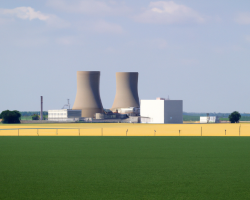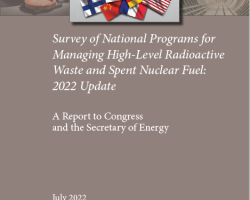Category of Content
Siting Experience Documents Only
Publication Date
Subject Matter
Repository Layout and Required Ventilation Trade Studies in Clay-Shale using the DSEF Thermal Analytical Mode
Repository Layout and Required Ventilation Trade Studies in Clay-Shale using the DSEF Thermal Analytical Mode
Deep Borehole Field Test: Characterization Borehole Science Objectives
Deep Borehole Field Test: Characterization Borehole Science Objectives
Public Preferences Related to Consent-Based Siting of Radioactive Waste Management Facilities for Storage and Disposal: Analyzing Variations over Time, Events, and Program Designs ?
Public Preferences Related to Consent-Based Siting of Radioactive Waste Management Facilities for Storage and Disposal: Analyzing Variations over Time, Events, and Program Designs ?
Cavern/Vault Disposal Concepts and Thermal Calculations for Direct Disposal of 37- PWR Size: DPCs
Cavern/Vault Disposal Concepts and Thermal Calculations for Direct Disposal of 37- PWR Size: DPCs
Public Views about Storage and Disposal Options for Spent Nuclear Fuel. Energy and Environment Survey, 2017
Public Views about Storage and Disposal Options for Spent Nuclear Fuel. Energy and Environment Survey, 2017
Review of Underground Construction Methods and Opening Stability for Repositories in Clay/Shale Media
Review of Underground Construction Methods and Opening Stability for Repositories in Clay/Shale Media
Review of Underground Construction Methods and Opening Stability for Repositories in Clay Shale Media
Review of Underground Construction Methods and Opening Stability for Repositories in Clay Shale Media
REPOSITORY NEAR-FIELD THERMAL MODELING UPDATE INCLUDING ANALYSIS OF OPEN MODE DESIGN CONCEPTS, Draft Rev M
REPOSITORY NEAR-FIELD THERMAL MODELING UPDATE INCLUDING ANALYSIS OF OPEN MODE DESIGN CONCEPTS, Draft Rev M
REPOSITORY NEAR-FIELD THERMAL MODELING UPDATE INCLUDING ANALYSIS OF OPEN MODE DESIGN CONCEPTS
REPOSITORY NEAR-FIELD THERMAL MODELING UPDATE INCLUDING ANALYSIS OF OPEN MODE DESIGN CONCEPTS
Deep Borehole Disposal Research: Geological Data Evaluation, Alternative Waste Forms, and Borehole Seals
Deep Borehole Disposal Research: Geological Data Evaluation, Alternative Waste Forms, and Borehole Seals
A Salt Repository Concept for CSNF in 21-PWR Size Canisters
A Salt Repository Concept for CSNF in 21-PWR Size Canisters
A Salt Repository Concept for CSNF in 21-PWR Size Canisters, Rev 2
A Salt Repository Concept for CSNF in 21-PWR Size Canisters, Rev 2
Interim Storage, Environmental Justice, and Generational Equity
Interim Storage, Environmental Justice, and Generational Equity
With the termination of the Yucca Mountain project, which was proposed to be our nation’s first repository for the disposal of military and civilian spent nuclear fuel and high-level radioactive waste, the future of nuclear waste management and disposal in this country became increasingly uncertain. Interim storage has been advocated by many as a temporary solution while a permanent solution is studied for potentially several more decades to come.
Intergenerational Ethical Issues and Communication Related to High-Level Nuclear Waste Repositories
Intergenerational Ethical Issues and Communication Related to High-Level Nuclear Waste Repositories
Purpose of Review: The nuclear power industry started in the 1950s and has now reached a phase of disposing high-level nuclear waste. Since the 1980s, the United Nations has developed a concept of sustainable development and governments have accordingly made ethical commitments to take responsibility towards future generations. The purpose of this review is to examine ethical dilemmas related to high-level nuclear waste disposal in a long-term perspective including potential access to the waste in the future.
Reset of America's Nuclear Waste Management Strategy and Policy
Reset of America's Nuclear Waste Management Strategy and Policy
The U.S. nuclear waste management program has labored for decades at a cost of billions of dollars each year, and yet there is still no active disposal program either for spent nuclear fuel from commercial reactors or for the high-level radioactive legacy waste and spent nuclear fuel from defense programs.
Interim Storage, Environmental Justice, and Generational Equity
Interim Storage, Environmental Justice, and Generational Equity
With the termination of the Yucca Mountain project, which was proposed to be our nation’s first repository for the disposal of military and civilian spent nuclear fuel and high-level radioactive waste, the future of nuclear waste management and disposal in this country became increasingly uncertain. Interim storage has been advocated by many as a temporary solution while a permanent solution is studied for potentially several more decades to come.
Communicating Risks and Benefits: An Evidence-Based User's Guide
Communicating Risks and Benefits: An Evidence-Based User's Guide
Effective risk communication is essential to the well-being of any organization and those people who depend on it. Ineffective communication can cost lives, money, and reputations. Communicating Risks and Benefits: An Evidence-Based User's Guide provides the scientific foundations for effective communication.
Science based responses to social myths on nuclear energy
Science based responses to social myths on nuclear energy
In order to promote a sound basis for considering the role of nuclear in climate change, this review spans the technical topics of social and political debate surrounding nuclear energy with a focus on the objective science of these issues including nuclear waste, accidents and overall risk. Novel aspects include the emergence of nuclear energy as being potentially renewable and the antithesis of Fukushima being an argument for the unacceptable risks associated with the use of nuclear energy.
Survey of National Programs for Managing High-Level Radioactive Waste and Spent Nuclear Fuel: 2022 Update
Survey of National Programs for Managing High-Level Radioactive Waste and Spent Nuclear Fuel: 2022 Update
In October 2009, the U.S. Nuclear Waste Technical Review Board (Board or NWTRB) published Survey of National Programs for Managing High-Level Radioactive Waste and Spent Nuclear Fuel. For each of the 13 national programs studied, the report catalogued 15 institutional arrangements that had been set in place and 15 technical approaches that had been taken to design repository systems for the long-term management of high-activity radioactive waste.


